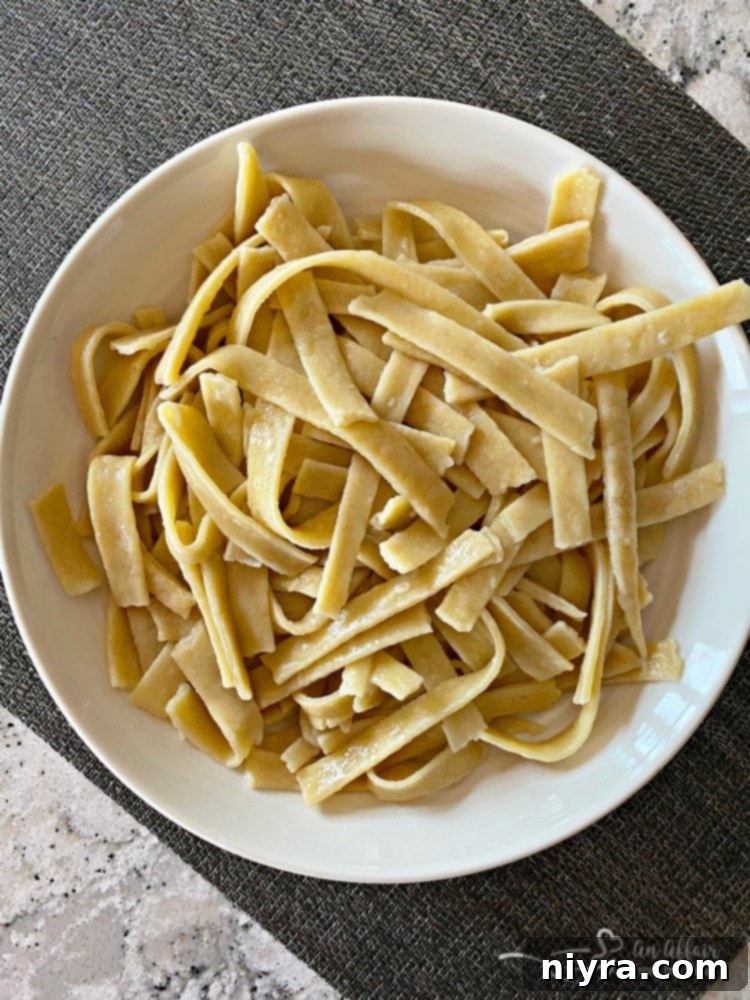While the convenience of store-bought egg noodles is undeniable, the exquisite taste, superior texture, and surprisingly efficient cooking time of homemade egg noodles truly elevate any dish. Embark on a culinary journey to rediscover the simple joys of making fresh pasta from scratch.
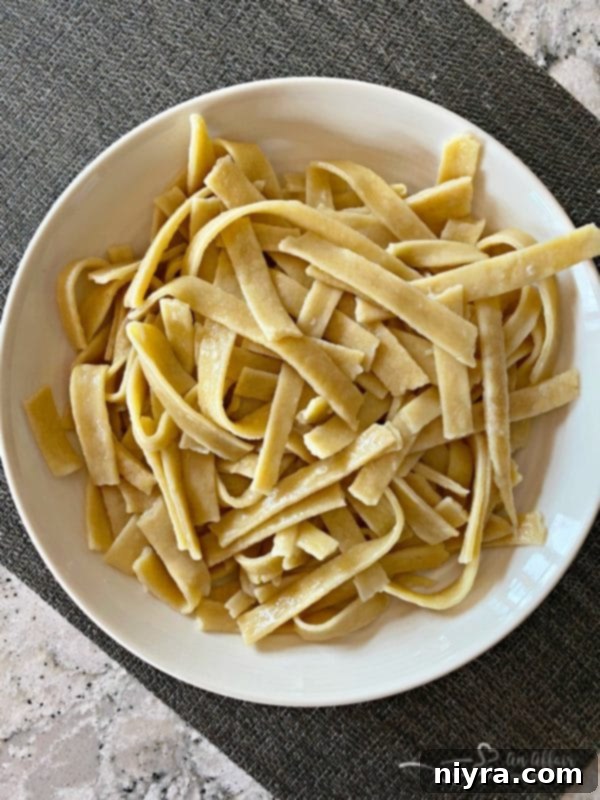
The Timeless Tradition of Homemade Egg Noodles
Growing up, our kitchen was always a hub of activity, especially when it came to preparing heartwarming meals. One of my fondest childhood memories revolves around the aroma of freshly made egg noodles. We never resorted to frozen or boxed varieties; my mother, a true kitchen wizard, insisted on making them herself. These delicate strands were an essential component of her legendary homemade chicken noodle soup and her rich beef and noodles.
I cherished every moment spent by her side, helping to create these culinary masterpieces. Our flour-dusted kitchen table served as the canvas where we would meticulously roll out the pliable dough. Then, with practiced hands, we would slice it into thin, perfect noodles. I can still vividly recall draping the freshly cut noodles over the back of kitchen chairs or carefully laying them out to dry on one of my grandmother’s many hand-embroidered flour sack towels. These simple acts weren’t just about making food; they were about preserving a tradition, sharing stories, and infusing love into every bite.

Crafting Old-Fashioned Egg Noodles: A Taste of Nostalgia
When people reminisce about the “good old days,” I’m certain that the comforting taste of homemade egg noodles is a significant part of that cherished sentiment. These noodles carry a unique flavor profile that evokes a deep sense of nostalgia and personal comfort, transporting you back to simpler times with every spoonful.
Despite their gourmet appeal, the process of making your own egg noodles is surprisingly straightforward and incredibly rewarding. It begins with combining a few simple ingredients to form a dough. This is where the fun starts! Working with the dough feels much like playing with Play-Doh – a tactile, engaging experience that never truly loses its charm. You knead it, roll it out evenly, and then deftly slice it into strips. The entire process, from mixing to cutting, doesn’t actually take very long, unless, of course, you find yourself getting delightfully carried away, shaping and playing with the dough!
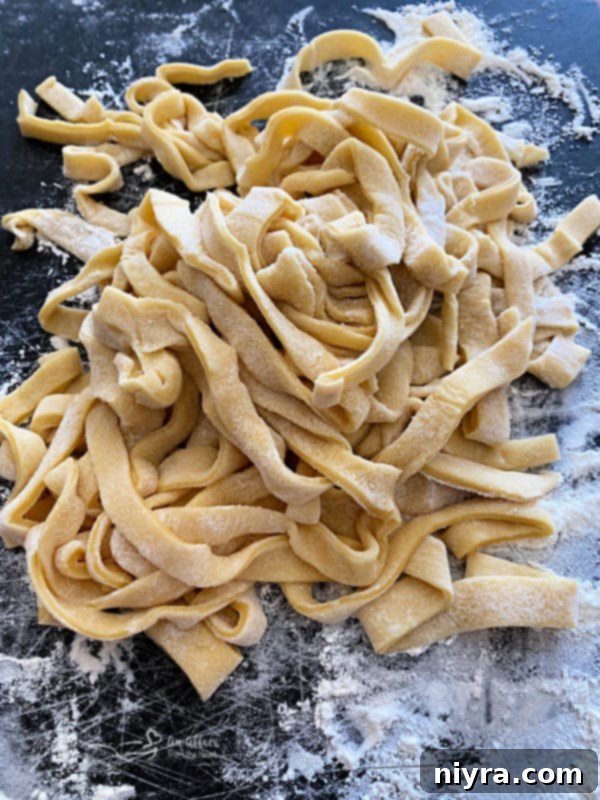
A Grandparent’s Genius: Homemade Noodles in a Camper
One particular memory that stands out vividly is a visit to my grandparents at a campsite in Valentine, Nebraska, when I was a little girl. My brother and I would burst out of the car, sprinting towards their camper, only to come to a joyful halt and dive into the green canvas hammocks, complete with white fringe, that they always set up under a tree. We absolutely adored lounging in those hammocks, feeling the gentle sway.
My grandma emerged from the camper to greet us, and I, ever curious, asked what she had been up to. With a warm smile, she explained that she had just finished making egg noodles for the chicken soup we’d be having for dinner, as the evening promised a chill in the air. I remember being utterly amazed, thinking, “My Grandma just made homemade egg noodles in a camper! There’s nothing she can’t do!” This anecdote perfectly illustrates the enduring spirit of home cooking and the simplicity of preparing these delicious noodles, no matter the setting.

The Simplicity of Ingredients for Perfect Egg Noodles
Creating these delightful, simple egg noodles requires only a handful of staple ingredients that you likely already have in your pantry: flour, eggs, salt, a touch of oil, and water. While you might be tempted to experiment with different types of flour, such as whole wheat, for an authentic, traditional flavor that would make my mom and grandma proud, I strongly recommend sticking with good old all-purpose flour. This classic choice ensures the soft, tender texture that homemade egg noodles are renowned for.
The beauty of this recipe lies in its timeless nature and accessibility. Honestly, there’s no grand secret here; this particular method is often found in classic cookbooks, much like that famous red and white checkered volume that has graced countless kitchen shelves for generations. It’s a foundational recipe that consistently delivers.
With these basic ingredients, you’ll achieve a soft, pliable noodle that cooks to a perfect al dente consistency in just a few minutes. The only real challenge you might face isn’t about texture or taste – it’s whether you’ve made enough to satisfy everyone’s cravings! These noodles are so irresistibly good, they tend to disappear quickly.
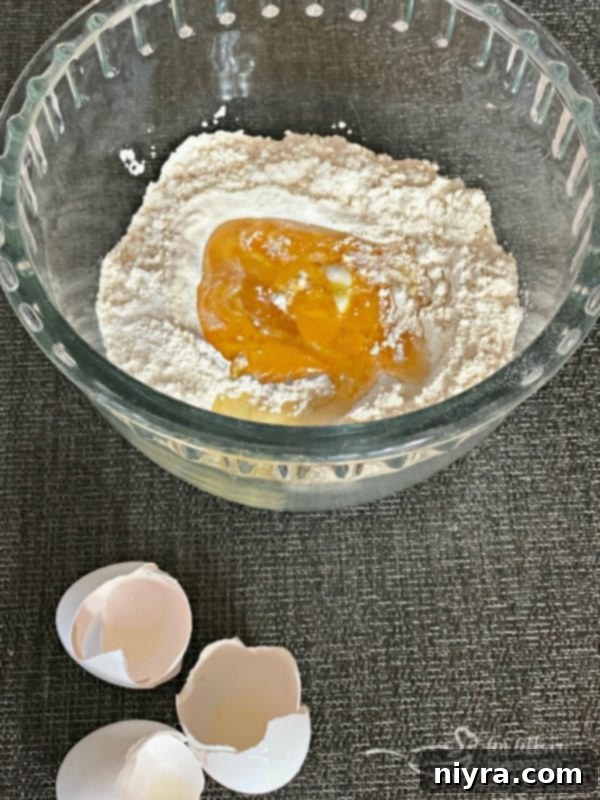
Mastering the Dough: Mixing Your Egg Noodles
The first step in crafting your homemade egg noodles is mixing the dough. If you ever took Home Economics, you might recall learning the “well” method for baking. This technique is perfect here: simply make a crater in the center of your dry ingredients, specifically the flour, and then pour the wet ingredients directly into this hollow before gradually combining everything. This helps to prevent lumps and ensures a smoother, more evenly hydrated dough.
As you mix, you can slowly add more water, a tablespoon at a time, until you achieve the desired consistency. You’re looking for a dough that is smooth, firm, yet wonderfully elastic. Once the ingredients are well incorporated and the dough begins to come together, turn it out onto a lightly floured surface. Now, it’s time to knead! Kneading is a crucial step that develops the gluten, which is essential for giving your noodles their characteristic chew and structure. Knead the dough for about 8-10 minutes, or until it feels smooth and elastic to the touch.
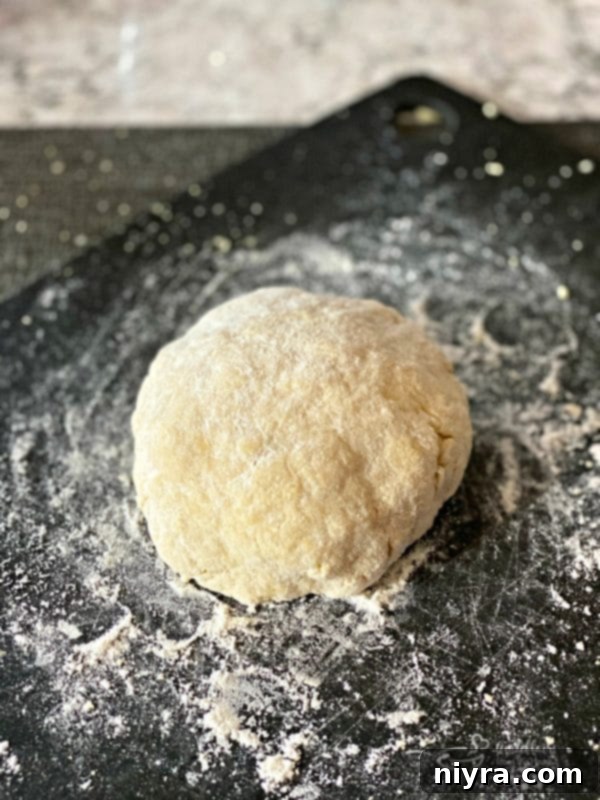
The goal of kneading is to activate and strengthen those gluten strands. These microscopic protein networks are what give the dough its elasticity and tensile strength, ultimately contributing to the perfect textured noodle that holds its shape beautifully when cooked. Once kneaded, form the dough into a ball, cover it with a clean towel, and let it rest for about 10 minutes. This resting period allows the gluten to relax, making the dough much easier to roll out.
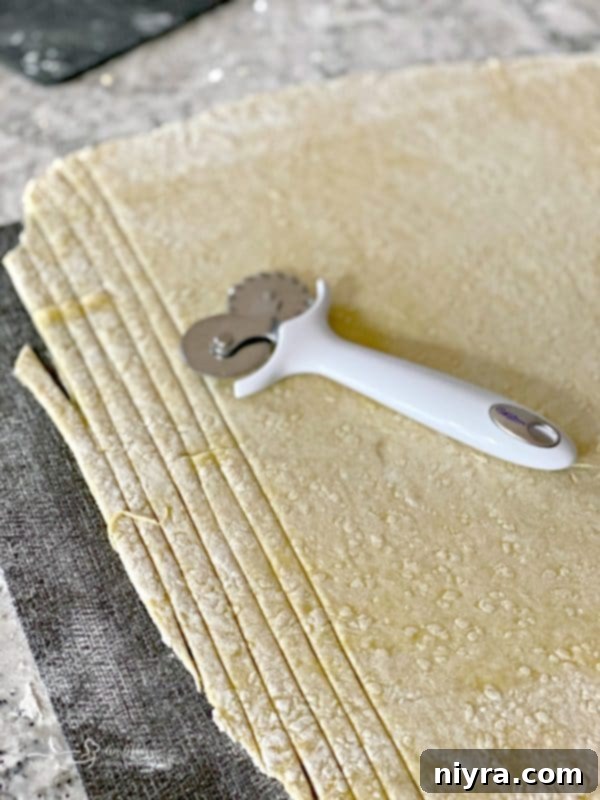
Precision Cutting: Shaping Your Homemade Noodles
After your dough has had its well-deserved rest, it’s time for the exciting step of cutting. Divide the dough into manageable portions, then take each portion and roll it out onto a lightly floured surface to your desired thickness. For classic egg noodles, aim for a thickness between 1/8th and 1/16th of an inch. A thinner dough will result in more delicate noodles, while a slightly thicker one will yield a heartier texture.
When it comes to cutting the noodles, you have several options. A specialized noodle cutter is ideal, but a pizza cutter, pastry cutter, or even a sharp knife works wonderfully. If you’re lucky enough to have a pasta machine or noodle extruder, those can certainly speed up the process and ensure uniform results. The width of your noodles can vary depending on the dish you plan to use them in. For instance, I typically cut my egg noodles about ¼ inch wide, which is versatile for most soups and casseroles. Consider the recipe you’re preparing and let that guide your decision on noodle width.
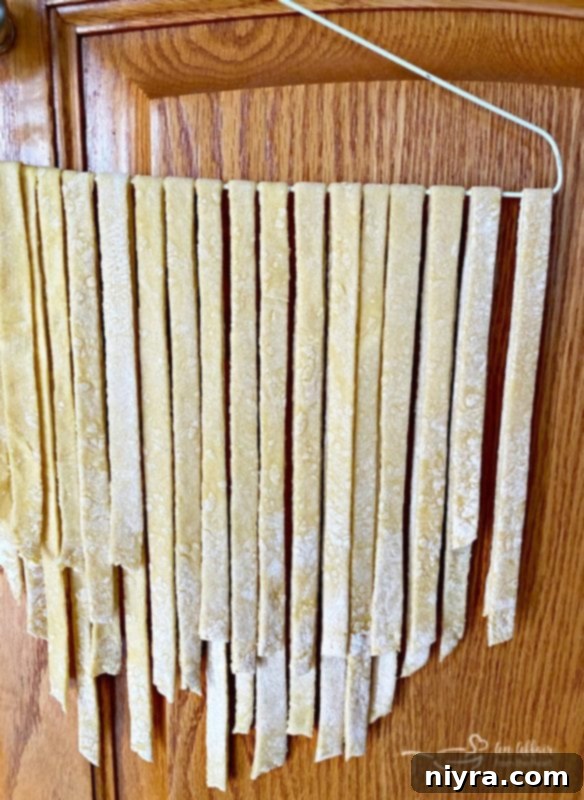
Drying Homemade Egg Noodles: Practical Tips and Personal Tales
The drying process is a crucial step for homemade egg noodles, especially if you plan to store them. As a child, I remember my mom and grandmas hanging them over kitchen chairs or, like my stepdad’s mother, using a broom handle propped between two counters. These methods worked perfectly in a quieter household. However, in my home, with two enthusiastic and rather clever boxers, such traditional methods would be an invitation to a noodle-snatching frenzy! If I were to leave the room, I’d undoubtedly return to find the chair-hung noodles vanished, leaving only a tell-tale dusting of flour on their adorable faces!

Initially, I tried the hanger technique to dry my noodles. While effective, I found them still slightly damp and doughy on the insides, especially as I planned to cook them that very evening. So, I transferred them from the hanger and laid them out on a clean tea towel spread across my counter. This method allowed them to dry more evenly and completely. The whole process, from cutting to being ready for the pot, took only a couple of hours, resulting in perfectly prepared noodles ready for boiling.
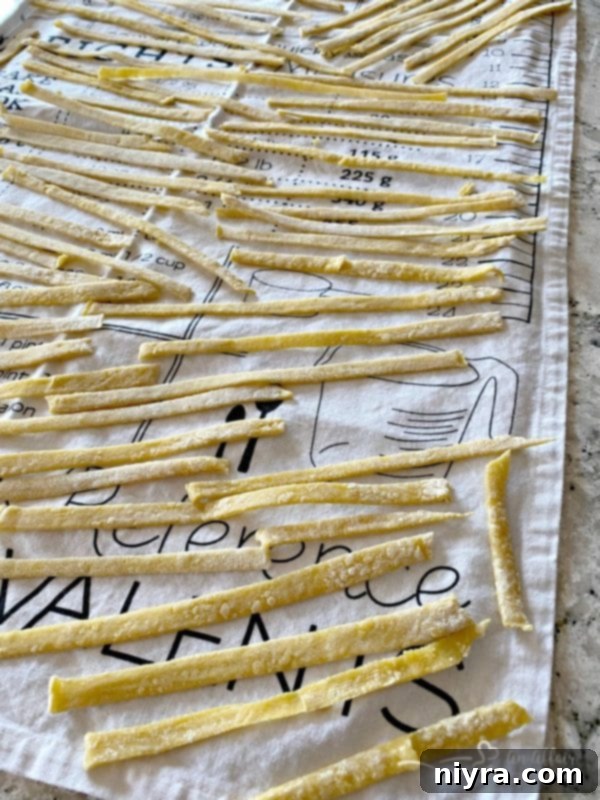
To Dry or Not to Dry: The Egg Noodle Debate & Storage
There’s a friendly debate in the culinary world regarding whether to fully dry homemade egg noodles before cooking. I was always taught to dry them completely, especially for storage. Some cooks argue that drying is only necessary if you intend to store them for later use, suggesting that fresh, undried noodles can go straight into the boiling water for a slightly faster cooking time. Ultimately, the choice is yours, based on your preference and immediate plans. For continuity and tradition, I continued to dry mine as I learned in childhood.
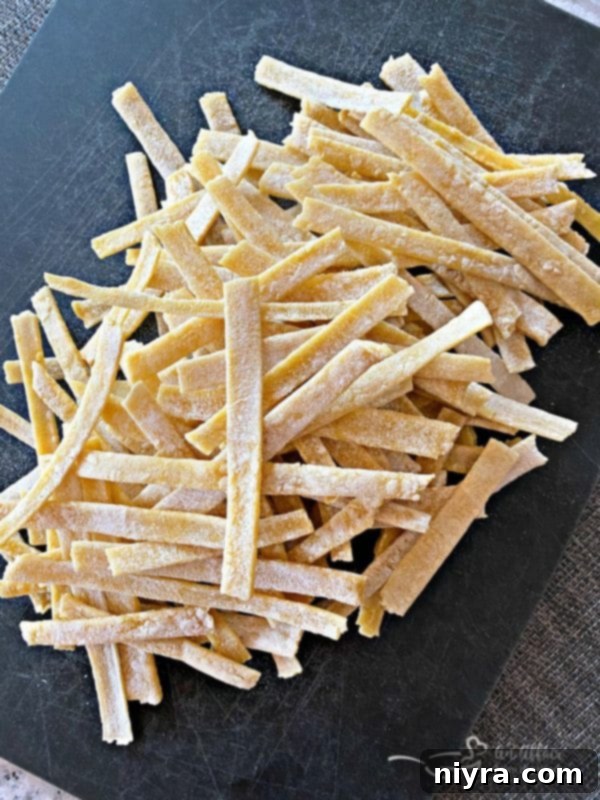
Proper storage is key if you’ve made a batch of these delicious noodles. To store homemade egg noodles, ensure they are thoroughly dried. Once completely dry, place them in an airtight container and store them in the refrigerator for up to 3 days. For longer preservation, dried noodles can be placed in a freezer bag or freezer-safe container and stored frozen for up to 8 months. This way, you can enjoy the fresh taste of homemade noodles anytime inspiration strikes.

^Love it? Pin it!^
If you’re eager to try this rewarding recipe for homemade egg noodles, be sure to pin it to your favorite Pinterest board. That way, you can easily find it whenever you’re ready to create these culinary delights!
Cooking Homemade Egg Noodles to Perfection
One of the most appealing aspects of fresh homemade egg noodles is their incredibly fast cooking time. To cook them, bring a large pot of salted water to a rolling boil. Gently drop the noodles into the vigorously boiling water. They will initially sink to the bottom of the pot. Keep an eye on them; as soon as they rise to the surface, they are ready! Depending on their width and thickness, homemade egg noodles typically cook in anywhere from 3 to 7 minutes. Be sure to stir them gently a few times to prevent them from sticking together.
These versatile noodles can be enjoyed in countless ways. A simple preparation with just a pat of butter and a sprinkle of grated Parmesan cheese is a pure delight, showcasing their fresh flavor and tender texture. Alternatively, they are an exceptional addition to virtually any noodle dish you can envision, from hearty stews to creamy casseroles.
If you’re incorporating them into a soup, add the noodles during the final few minutes of cooking. This allows them to cook quickly and retain their ideal texture. Like any delicate pasta, homemade noodles can become overly soft or even break apart if left to simmer for too long in hot broth or stock, so timing is key for the perfect result.

Recommended Recipes for Fresh Egg Noodles
Homemade egg noodles elevate a wide array of dishes, transforming everyday meals into extraordinary culinary experiences. From comforting soups to rich stroganoffs and hearty casseroles, these fresh noodles truly make everything taste better than ever.
- Italian Chicken Noodle Soup (pictured above)
- Beef and Noodles
- Turkey Noodle Soup
- Hamburger Noodle Soup
- Five Bean Beef and Noodle Skillet
- Polish Noodles and Sauerkraut (Kluski Kapusta Kiszona)
- Creamy Kraut and Mushrooms with Noodles
- 20 Minute Chicken & Noodles
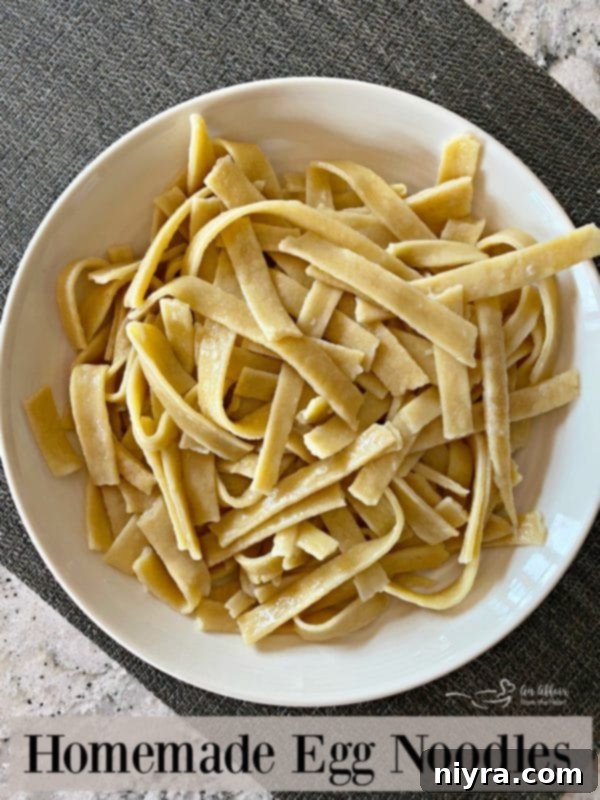
While pre-packaged noodles certainly have their place for convenience, crafting your own homemade egg noodles offers an unparalleled sense of accomplishment and a distinctly superior flavor and texture. The freshness and authentic taste simply cannot be matched. It’s a gratifying culinary experience that I believe is truly worth the effort. Why not give it a try and taste the difference for yourself?

LIKE THIS RECIPE?
Don’t forget to give it a ⭐️⭐️⭐️⭐️⭐️ star rating and
leave a comment below the recipe!

Print Recipe
Homemade Egg Noodles
Equipment
- KitchenAid Classic Pizza Wheel
- Kitchenaid Stand Mixer
Ingredients
- 1 3/4 cups all-purpose flour
- 2 egg yolks slightly beaten
- 1 egg slightly beaten
- 1/2 teaspoon salt
- 1/3 cup water
- 1 teaspoon cooking oil
Instructions
- In a bowl, add flour. Make a “well” in the center of the flour.
- Combine eggs, salt, water and oil in another bowl.
- Add wet mixture to the well.
- Mix together until ingredients are incorporated.
- Flour a flat surface. Turn dough out and begin to knead the dough until it’s smooth and elastic. About 8 minutes or so. (alternatively, you can use your dough hook attachment for your stand mixer.)
- Form dough into a ball. Cover with a clean towel and let sit for 10 minutes before rolling out on a floured surface.
- Cut noodles 1/8″ thick and 1/4″ wide.
- Hang or lay on a lightly floured tea towel to dry for a couple of hours.
- To cook, add noodles to a salted pot of water that has come to a rapid bowl. Noodles will rise to the surface in 4-7 minutes and be cooked. Stir to keep them separated.
- Serve immediately, or add to soups or casseroles.
Notes
You can cook noodles without drying if you prefer – they will cook faster.
To store egg noodles, make sure they are dried completely, and place them in an airtight container. Store in the fridge for up to 3 days. Or place dried noodles in a freezer bag or freezer container, and store frozen for up to 8 months.
